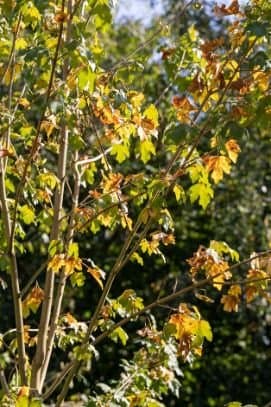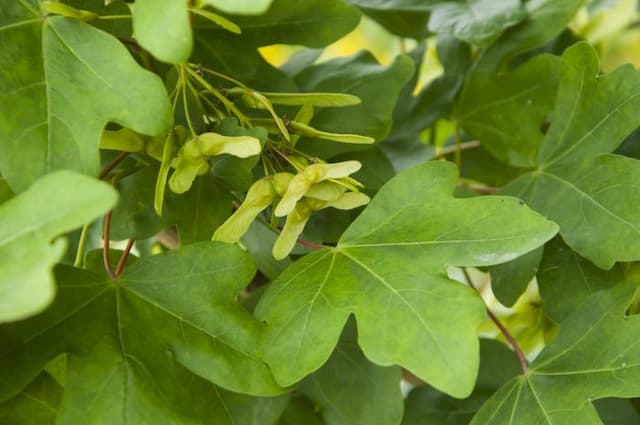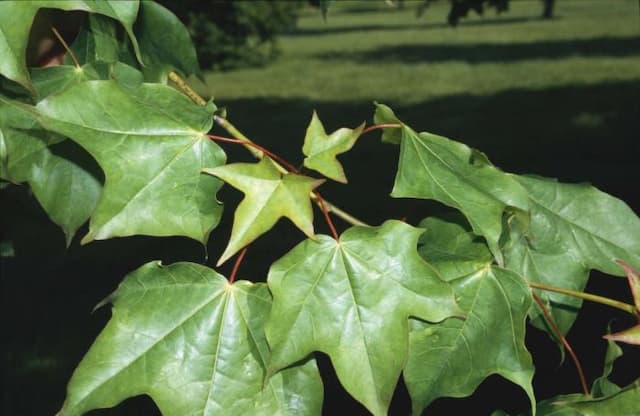Japanese Maple Acer palmatum 'Dissectum Nigrum' (D)

ABOUT
Acer palmatum 'Dissectum Nigrum', otherwise known as the Japanese maple 'Dissectum Nigrum', is a striking ornamental plant renowned for its unique and beautiful foliage. It is characterized by its delicate and deeply dissected leaves, which give the plant a feathery or lace-like appearance. The leaves are a deep purple or maroon color, creating a rich tapestry of dark foliage throughout the growing seasons. Each leaf is finely cut into several narrow lobes that spread out from the central leaf stem, and they gracefully cascade down from the branches which creates a weeping effect that adds a sense of movement and elegance to the plant's overall form. During different times of the year, the foliage color can go through subtle changes. In spring, the new leaves may emerge with a reddish hue, gradually maturing to the deeper purple or maroon color for which it is known. Then, when cooler temperatures arrive in the fall, the leaves may transform again, often taking on reddish and bronze tones before they fall from the plant. Another distinctive feature of the Japanese maple 'Dissectum Nigrum' is its branching pattern. The branches spread out horizontally and then gently droop, creating a mounded shape that contributes to the aesthetic appeal of the specimen. The bark of the plant is also noteworthy, being a smooth gray that can become more textured with age. Overall, the Japanese maple 'Dissectum Nigrum' is admired for its elegant and sculptural qualities, offering a dramatic visual impact in the landscape throughout the year. It is a favorite among garden enthusiasts and landscape designers who seek to incorporate its rich color and graceful form into gardens and outdoor settings.
About this plant
 Names
NamesSynonyms
Purple Laceleaf Japanese Maple, Dissectum Nigrum Japanese Maple, Black Laceleaf Japanese Maple.
Common names
Acer palmatum var. dissectum 'Atropurpureum'
 Toxicity
ToxicityTo humans
Japanese Maple is generally not considered toxic to humans. Ingestion of any part of this plant typically does not lead to poisoning or produce harmful effects.
To pets
Japanese Maple is also generally regarded as non-toxic to pets. It is not known to cause poisoning in animals if they ingest parts of the plant; therefore, pet owners usually do not need to worry about toxicity from this plant.
 Characteristics
CharacteristicsLife cycle
Perennials
Foliage type
Deciduous
Color of leaves
Purple
Height
6-8 feet (1.8-2.4 meters)
Spread
6-8 feet (1.8-2.4 meters)
Plant type
Tree
Hardiness zones
5-8
Native area
Japan
Benefits
 General Benefits
General Benefits- Aesthetic Appeal: The Japanese Maple 'Dissectum Nigrum' has finely-cut, lace-like leaves that turn a deep purple or red. Its distinct foliage provides a striking visual interest throughout the seasons.
- Seasonal Color Variation: It offers vibrant seasonal color changes, with leaves turning from dark purple in spring, to red-purple in summer, and finishing with a brilliant red in autumn.
- Shade Tolerance: This variety of Japanese Maple can thrive in partial shade conditions, making it a versatile choice for different garden locations.
- Compact Size: With a naturally small stature, it is suitable for smaller gardens or spaces and can also be grown in containers.
- Low Maintenance: Requiring minimal pruning, it is a good choice for gardeners who desire attractive landscapes with less effort.
- Structural Interest in Winter: Even without leaves, the intricate and weeping branch structure adds interest to winter landscapes.
- Enhances Garden Design: Its unique form and color can serve as a focal point or accent in landscape design, complementing other plants and features.
 Medical Properties
Medical PropertiesThis plant is not used for medical purposes.
 Air-purifying Qualities
Air-purifying QualitiesThis plant is not specifically known for air purifying qualities.
 Other Uses
Other Uses- Photography Backdrop: The lace-like foliage of the Japanese Maple provides a delicate and interesting background for macro and close-up photography.
- Bonsai Specimen: Prized for its intricate leaf pattern and shape, it can be cultivated as a bonsai for traditional Japanese art.
- Culinary Presentation: Chefs may use the leaves as a decorative element when plating dishes, especially in Japanese cuisine.
- Artistic Inspiration: Artists and designers often draw inspiration from the unique form and color of the Japanese Maple for works of art and patterns.
- Education and Study: Used in botany and horticulture programs to teach about plant taxonomy and pruning techniques.
- Feng Shui: Some practitioners use the Japanese Maple in their garden designs to enhance the chi flow, particularly in the wealth and prosperity areas.
- Seasonal Celebrations: In Japan, viewing the changing colors of maple leaves in autumn (momijigari) is a popular activity, and this variety adds a unique color to the palette.
- Theme Gardens: Perfect specimen for creating themed gardens, such as Japanese zen gardens or woodland/shade gardens.
- Craft Material: Dried or pressed leaves can be used in crafting, for instance, in scrapbooking, or as a natural material for eco-printing on fabric.
- Aquascaping: Although not submerged, the branches might sometimes be used in the art of aquascaping to create natural-looking landscapes above water levels in an aquarium set-up.
Interesting Facts
 Feng Shui
Feng ShuiThe Japanese Maple is not used in Feng Shui practice.
 Zodiac Sign Compitability
Zodiac Sign CompitabilityThe Japanese Maple is not used in astrology practice.
 Plant Symbolism
Plant Symbolism- Beauty: The intricate leaves and beautifully arching branches of the Japanese Maple ('Dissectum Nigrum') symbolize beauty in nature.
- Peace and Calm: The delicate leaves and serene growth habit represent peace and calm, creating tranquil spaces.
- Endurance and Change: As a species that experiences vibrant seasonal changes, it embodies endurance and the ability to adapt and flourish through change.
- Balance: The balanced shape and form of the Japanese Maple capture the essence of harmony and balance in life.
- Grace: The graceful growth pattern of this plant signifies elegance and poise.
 Water
WaterThe Japanese Maple should be watered deeply once a week during the growing season, especially if there’s no significant rainfall. During hot or dry periods, the frequency should increase to possibly twice a week. Ensure the soil is moist but not soggy, allowing the top inch of soil to dry out between watering sessions. Apply about 10 to 15 gallons of water each time for mature trees to thoroughly saturate the root zone. In winter, reduce watering since the tree will be dormant.
 Light
LightJapanese Maples thrive in locations that offer full sun to partial shade. The ideal spot would provide morning sun and afternoon shade, protecting the delicate leaves from the harsh midday sun. They can tolerate full sun in cooler climates but need more protection from intense sunlight in hotter regions.
 Temperature
TemperatureJapanese Maples are hardy and can tolerate a range of temperatures. They can survive winter temperatures as low as -20°F and are comfortable in summer temperatures up to 90°F. Ideally, they prefer to be in an environment where the average temperature ranges between 60°F to 70°F, avoiding extreme heat or cold.
 Pruning
PruningPrune Japanese Maples to remove dead or crossing branches and to shape the tree for aesthetic purposes. The best time to prune is late winter or early spring before new growth begins. Light pruning can be done periodically through the growing season if necessary.
 Cleaning
CleaningAs needed
 Soil
SoilThe Japanese Maple prefers well-draining soil rich in organic material, a soil mix incorporating peat moss, perlite, and pine bark in equal parts works well. A slightly acidic to neutral pH, between 5.5 and 7.5, is ideal for optimal growth and health.
 Repotting
RepottingJapanese Maples should generally be repotted every 2-3 years to ensure they are not becoming root-bound and to refresh the soil. Younger, faster-growing trees may require more frequent repotting.
 Humidity & Misting
Humidity & MistingJapanese Maples thrive in moderate humidity levels and do not require as high humidity as some tropical plants. Aim to maintain ambient humidity, especially during dry winter months.
 Suitable locations
Suitable locationsIndoor
Ensure bright indirect light, and protect from hot drafts.
Outdoor
Provide dappled shade, shelter from strong winds.
Hardiness zone
5-9 USDA
 Life cycle
Life cycleThe life of a Japanese Maple 'Dissectum Nigrum' begins with germination, where the seed sprouts in suitable conditions of moisture, temperature, and light. It progresses to the seedling stage, where the primary leaves unfold and the root system starts to develop. As the plant enters the vegetative stage, it grows its distinctive, finely cut, lace-like, purple leaves, and the stem thickens. This cultivar reaches maturity in several years, developing a weeping form and can produce small reddish-purple flowers followed by winged samaras (seeds) in the reproductive stage. As a perennial woody plant, it enters a cycle of annual growth, flowering, and dormancy, exhibiting vibrant autumn foliage before shedding its leaves for winter. With proper care, the Japanese Maple 'Dissectum Nigrum' can live for several decades, going through these cycles repeatedly.
 Propogation
PropogationPropogation time
Late summer
Propogation: The Japanese Maple tree, specifically the variety 'Dissectum Nigrum', is typically propagated through softwood cuttings or grafting. The most popular method for propagation is grafting, which should be done in late winter or early spring, just before the growing season begins. This process involves taking a branch or scion from the 'Dissectum Nigrum' and joining it onto the stock of a root system from another Acer palmatum variety. The graft union must be snug and secure, often wrapped with grafting tape, to ensure a successful join. This method is favored as it combines the desirable characteristics of 'Dissectum Nigrum', such as its dark foliage and finely dissected leaves, with the vigor and hardiness of the rootstock. After grafting, the plant should be kept in a humid environment to promote healing and prevent the scion from drying out. Once the graft has taken, usually evident by the growth of new leaves, the plant can be gradually introduced to less controlled outdoor conditions.







![Freeman maple [Autumn Blaze]](/_next/image?url=https%3A%2F%2Fplants-admin.emdemapps.com%2Fimages%2Fplants%2F%2Fimages%2F604b575b84d87.png&w=640&q=75)

